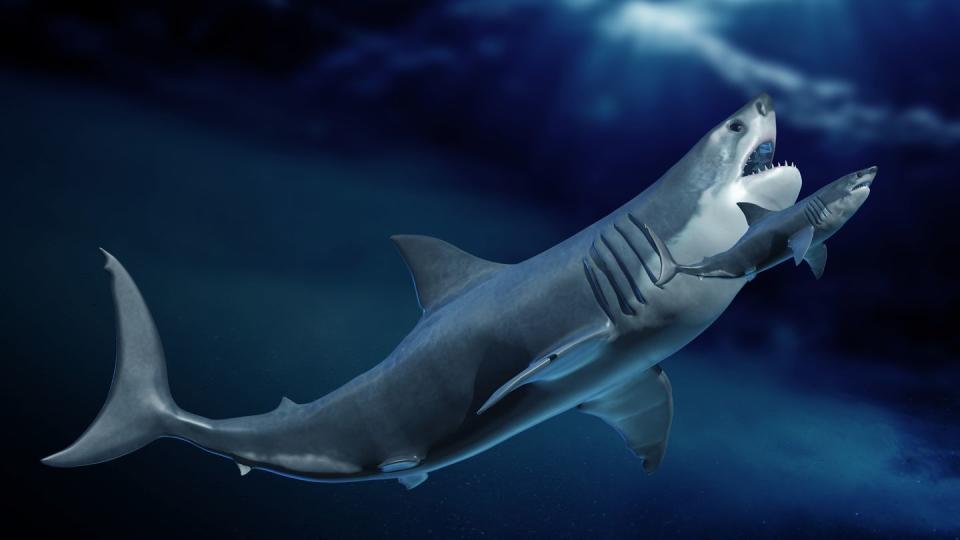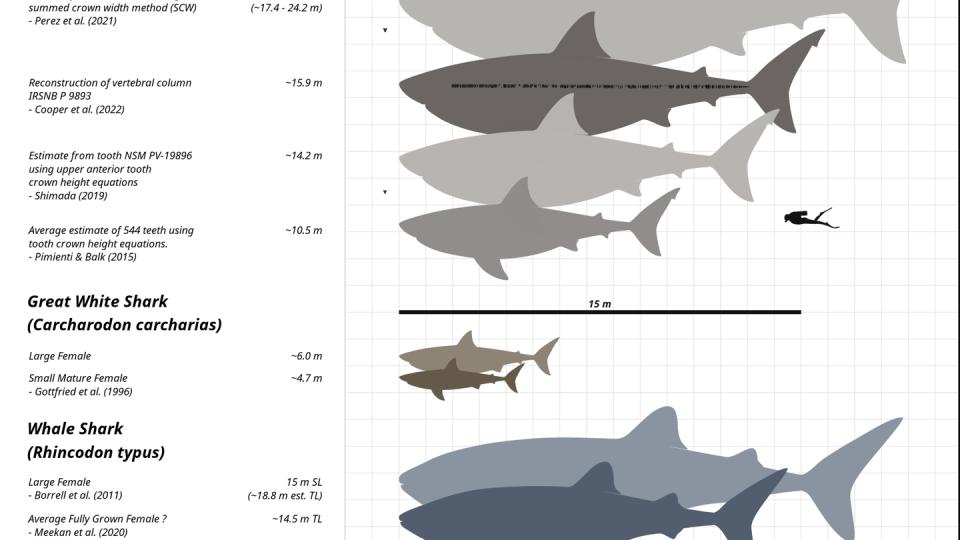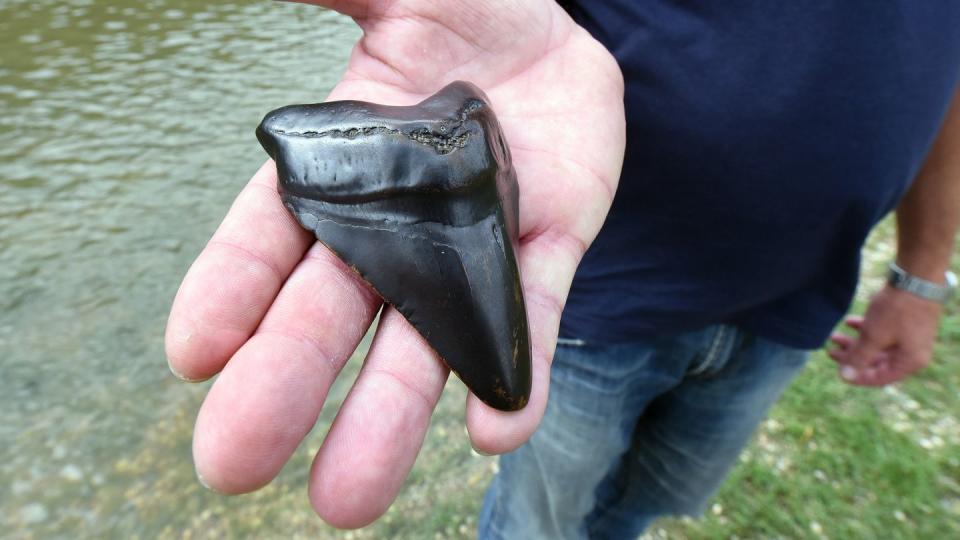Everything You Need to Know About the Real Megalodon, an Ancient ‘Big Tooth’ Shark

While movie megalodon is heightened for entertainment, the real thing was still huge.
Megalodon was a white or mackerel shark, related to today’s great white shark.
Some believe the whale shark is really the largest fish to ever live.
The movie version of megalodon is back in a new sequel, Meg 2: The Trench, indicating that this ancient megafauna’s charisma is still a major draw for audiences raised on “Shark Week.” But what’s the real megalodon all about? Thankfully, there are some facts in the mix about this million-year-old shark species and the modern sharks most like it.
The word “megalodon” is from the Greek roots megalos and odon, literally “big” and “tooth.” You might recognize odon from orthodontist or periodontist, but it’s also a very common name root for ancient creatures like dinosaurs and megafauna. There’s probably a simple explanation for that: the shape and size of teeth found with a particular fossil are some of the easiest ways to tell them apart quickly. And for some species, teeth are the only thing we ever find, or at least the only thing we’re able to categorize for a long time. Anodontosaurus, a dinosaur species, was misnamed this—“lack of” teeth, like a-theism or an-archy—until scientists found its teeth later. (Paleontology is littered with these discarded wrong names based on teeth!)
✅ More examples of “-odons”
• Astrodon, a sauropod dinosaur with star-shaped teeth
• Diplocynodon, an extinct genus of proto-alligators
• Glyptodonts, a family of extinct armadillos
• Odontophoridae, extinct and extant North American quails
• Palaeoplethodon, extinct Caribbean salamander
• Prognathodon, extinct marine lizard found globally
• Pycnodontiforms, extinct European bony fish
• Tinodon, extinct genus of mammal found in Europe
• Troodon, a genus of small dinosaurs we only know by their teeth
Megalodon is an extinct shark that’s considered the largest fish that ever lived. The largest shark is typically the largest fish, too, like today’s largest living fish, the whale shark. Sharks occupy a clade, or family group descended from a common ancestor, that’s divided into several smaller groups based on body styles and other characteristics. The mackerel sharks are also known as the white sharks; these are informal terms for technical ones like lamniform and lamnidae, both of which come from the Greek meaning “predator fish.” Megalodon is a mackerel shark, as is today’s great white shark. (Don’t confuse either thing with the very waters-muddying shark mackerel! Or the salmon shark, which is a mackerel shark.)
These sharks are named as such because they often swim in the same waters as mackerel fish, unlike mackerel tabby cats, which were named because their stripes can look like a fish skeleton. (“Mackerel” is a very old word for a very common food-source fish, which may be why its name is applied to so many other things.) They are quite large and very capable carnivores that feed on mackerel, salmon, herring, tuna, and more.
The white sharks more specifically are known as fearsome predators. This is a huge part of the popular imagination—if you picture a scary shark, chances are good you picture something like Jaws—and has almost supplanted real knowledge about the white sharks. They are able to swim so far and eat huge quantities without having much traditional rest, which makes them hard to study. Try throwing a dart at a moving target instead of a regular dartboard!
White sharks like megalodon also have an unusual body-heat system somewhere between cold-blooded and warm-blooded, and this allows them to cover even more latitude from north to south and in different depths of water. Both behaviors are uncommon for ocean fish, because the ocean’s temperature depth zones are surprisingly well organized. Some fish travel for miles horizontally, but never venture outside of their zone of the ocean’s depth because of the dangerous temperature change.
🎥 Still Hungry for More Megalodon Facts? Eat up our latest videos, and be sure to check out even more Meg content from paleontologist Dana Ehreton, Ph.D., on the Popular Mechanics TikTok account.
Megalodon has a lot in common with its present-day relative, the great white shark. Scientists believe megalodon was heavy and bulky compared with other kinds of fish, in line with the “torpedo-shaped” members of the white shark family. Encyclopedia Britannica explains that the fossil record leads scientists to estimate the largest megalodon was up to 58 to 82 feet long. To call megalodon the largest fish to ever exist, we must default to the estimate of 82 feet, because the longest whale shark we know of was 61.7 feet. (That was not based on an estimate, either, but an accurate measurement of a real animal.)
But there’s a personality dynamic at play when we think about the megalodon versus the whale shark. A more average 39-foot whale shark weighs about 30,000 pounds, while scientists estimate that the megalodon ranged from 66,000 pounds up to 143,000 pounds. And the whale shark is a docile scoop feeder, honestly closer to a baleen whale than our mental image of a scary shark. Encyclopedia Britannica calls the whale shark “harmless,” and its mouth contains up to 300 rows of the tiniest teeth. On the other hand, the largest megalodon tooth we have an example of is nearly 7 inches long and very pointed and sharp.


It’s easy to see how megalodon captures the public imagination. Scientists use the term “charismatic megafauna” to refer to animals like pandas and great white sharks. These animals capture our hearts or, in the case of the shark, our most personal-feeling fears. Megalodon also appeals in an almost cryptozoologic way, the way the Loch Ness Monster is thought to be an imaginative version of something like a sauropod dinosaur.
We understand the deep ocean very little, even today after decades of hard work by scientists around the world. It could be that megalodon is one part great white shark, one part shrouded-in-mystery giant squid. And that makes for very exciting viewing.
You Might Also Like
